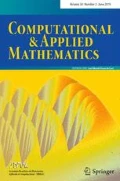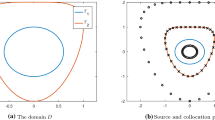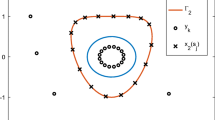Abstract
In this paper, a recent algorithm, based around the method of fundamental solutions (MFS), for reconstructing boundary data in inverse Stefan problems is extended and applied to inverse Cauchy–Stefan problems, wherein initial data must also be reconstructed. A key feature of the algorithm is that it is adaptive and iterates to find the optimal locations of the source points that are required by the method. Tikhonov regularization is used to take care of the ill-conditioned matrix that the MFS generates, with the algorithm being able to determine the optimal regularization parameter automatically. The effects of accuracy and random noise on the optimal location and number of source points are also evaluated. In addition, we consider a nonlinear variant of the inverse problem where one has to identify the moving boundary along with the missing initial data. Numerical experiments, carried out on five different benchmark examples, show promising results.

















Similar content being viewed by others
References
Ang DD, Dinh APN, Thanh DN (1996) An inverse Stefan problem: identification of boundary value. J Comput Appl Math 66(1):75–84
Beck JV, Blackwell B, Clair Jr CR (1985) Inverse heat conduction: ill-posed problems. New York Press
Cannon JR, Douglas J Jr (1967) The Cauchy problem for the heat equation. SIAM J Numer Anal 4:317–336
Cannon JR, Hill CD (1967) Existence, uniqueness, stability, and monotone dependence in a Stefan problem for the heat equation. J Math Mech 17(17):1–19
Cannon JR, Primicerio M (1971) Remarks on the one-phase Stefan problem for the heat equation with the flux prescribed on the fixed boundary. J Math Anal Appl 35(2):361–373
Chantasiriwan S, Johansson BT, Lesnic D (2009) The method of fundamental solutions for free surface Stefan problems. Eng Anal Bound Elem 33(4):529–538
Chen CS, Cho HA, Golberg MA (2006) Some comments on the ill-conditioning of the method of fundamental solutions. Eng Anal Bound Elem 30(5):405–410
Fredman TP (2004) A boundary identification method for an inverse heat conduction problem with an application in iron making. Heat Mass Transf 41:95–103
Gol\(^{\prime }\)dman NL (1997) Inverse Stefan Problems. Mathematics and Its Applications, vol 412. Kluwer Academic Publishers Group, Dordrecht
Hon YC, Li M (2008) A computational method for inverse free boundary determination problem. Int J Numer Methods Eng 73:1291–1309
Hussein MS, Lesnic D (2014) Determination of a time-dependent thermal diffusivity and free boundary in heat conduction. Int Commun Heat Mass 53:154–163
Johansson B, Lesnic D, Reeve T (2011a) A method of fundamental solutions for the one-dimensional inverse Stefan problem. Appl Math Model 35(9):4367–4378
Johansson BT, Lesnic D, Reeve T (2011b) Numerical approximation of the one-dimensional inverse Cauchy–Stefan problem using a method of fundamental solutions. Inverse Probl Sci Eng 19:659–677
Johansson BT, Lesnic D, Reeve T (2013) A meshless method for an inverse two-phase one-dimensional linear Stefan problem. Inverse Probl Sci Eng 21:17–33
Johansson BT, Lesnic D, Reeve T (2014a) A meshless method for an inverse two-phase one-dimensional nonlinear Stefan problem. Math Comput Simul 101:61–77
Johansson BT, Lesnic D, Reeve T (2014b) The method of fundamental solutions for the two-dimensional inverse Stefan problem. Inverse Probl Sci Eng 22:112–129
Karageorghis A (1992) The method of fundamental-solutions for the solution of steady-state free-boundary problems. J Comput Phys 98:119–128
Karageorghis A, Fairweather G (1987) The method of fundamental-solutions for the numerical-solution of the biharmonic equation. J Comput Phys 69:434–459
Karageorghis A, Fairweather G (1989) The method of fundamental-solutions for the solution of nonlinear plane potential problems. IMA J Numer Anal 9:231–242
Karageorghis A, Lesnic D, Marin L (2011) A survey of applications of the MFS to inverse problems. Inverse Probl Sci Eng 19(3):309–336
Klibanov MV (2006) Estimates of initial conditions of parabolic equations and inequalities via lateral Cauchy data. Inverse Probl 22:495–514
Lesnic D, Elliott L, Ingham D (1995) Treatment of singularities in time-dependent problems using the boundary element method. Eng Anal Bound Elem 16(1):65–70
Li J, Yamamoto M, Zou J (2009) Conditional stability and numerical reconstruction of initial temperature. Commun Pure Appl Anal 8:361–382
Liu CS (2014) An LGDAE method to solve nonlinear Cauchy problem without initial temperature. Comput Model Eng Sci 99:371–391
Liu CS, Chang CW (2015) A simple algorithm for solving Cauchy problem of nonlinear heat equation without initial value. Int J Heat Mass Transf 80:562–569
Liu J, Guerrier B (1997) A comparative study of domain embedding methods for regularized solutions of inverse Stefan problems. Int J Numer Methods Eng 40:3579–3600
Liu JC, Wei T (2013) A quasi-reversibility regularization method for an inverse heat conduction problem without initial data. Appl Math Comput 219:10866–10881
MacDonell M (1985) A boundary method applied to the modified H elmholtz equation in three dimensions, and its application to a waste disposal problem in the deep ocean. Master’s thesis, University of Toronto, Toronto, Canada
Manselli P, Vessella S (1991) On continuous dependence, on noncharacteristic Cauchy data, for level lines of solutions of the heat equation. Forum Math 3:513–521
Rad JA, Rashedi K, Parand K, Adibi H (2017) The meshfree strong form methods for solving one dimensional inverse Cauchy–Stefan problem. Eng Comput 33:547–571
Ramachandran PA (2002) Method of fundamental solutions: singular value decomposition analysis. Commun Numer Methods Eng 18(11):789–801
Reddy GMM, Vynnycky M, Cuminato JA (2018) On efficient reconstruction of boundary data with optimal placement of the source points in the MFS: application to inverse Stefan problems. Inverse Probl Sci Eng 26:1249–1279
Reddy GMM, Vynnycky M, Cuminato JA (2019) An efficient adaptive boundary algorithm to reconstruct Neumann boundary data in the MFS for the inverse Stefan problem. J Comput Appl Math 349:21–40
Reeve TH (2013) The method of fundamental solutions for some direct and inverse problems. Ph.D. thesis, University of Birmingham
Rubinstein LI (1971) The Stefan problem. American Mathematical Society, Providence. Translated from the Russian by A. D. Solomon, Translations of Mathematical Monographs, Vol 27
Takeuchi T (2007) An inverse numerical method by reproducing kernel Hilbert spaces and its applications to linear inverse problem. Ph.D. thesis, University of Tokyo
Wang YB, Cheng J, Nakagawa J, Yamamoto M (2010) A numerical method for solving the inverse heat conduction problem without initial value. Inverse Probl Sci Eng 18:655–671
Wei T, Yamamoto M (2009) Reconstruction of a moving boundary from Cauchy data in one-dimensional heat equation. Inverse Probl Sci Eng 17:551–567
Yang FL, Ling L, Wei T (2010) An adaptive greedy technique for inverse boundary determination problem. J Comput Phys 229:8484–8496
Acknowledgements
G. M. M. Reddy would like to thank FAPESP (Fundação de Amparo a Pesquisa do Estado de São Paulo) for the financial support received [Grant Number 2016/19648-9]. G. M. M. Reddy and P. Nanda would like to thank the Department of Science and Technology for support through the grant SRG/2019/001973. M. Vynnycky acknowledges the award of visiting researcher grants from the University of São Paulo, CNPq (Conselho Nacional de Desenvolvimento Científico e Tecnológico) [Grant Number 401945/2012-0] and FAPESP [Grant Number 2018/07643-8].
Author information
Authors and Affiliations
Corresponding author
Additional information
Communicated by Antonio José Silva Neto.
Publisher's Note
Springer Nature remains neutral with regard to jurisdictional claims in published maps and institutional affiliations.
Rights and permissions
About this article
Cite this article
Reddy, G.M.M., Nanda, P., Vynnycky, M. et al. An adaptive boundary algorithm for the reconstruction of boundary and initial data using the method of fundamental solutions for the inverse Cauchy–Stefan problem. Comp. Appl. Math. 40, 99 (2021). https://doi.org/10.1007/s40314-021-01454-1
Received:
Revised:
Accepted:
Published:
DOI: https://doi.org/10.1007/s40314-021-01454-1
Keywords
- Inverse Cauchy–Stefan problem
- Boundary identification problem
- Method of fundamental solutions
- Tikhonov regularization
- Adaptive boundary algorithm




